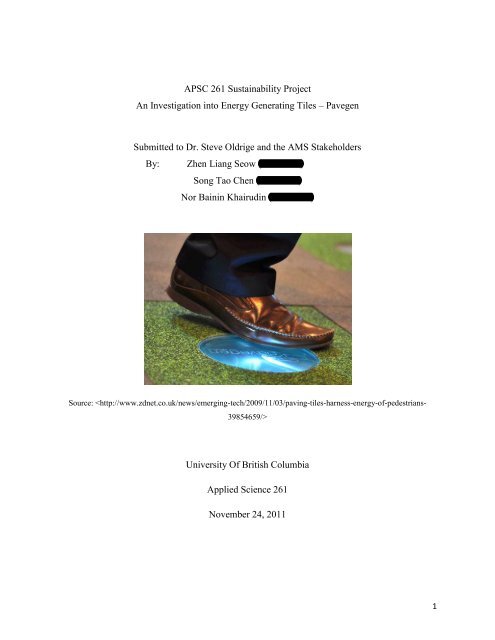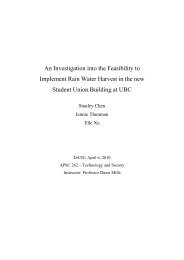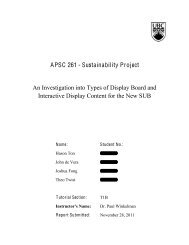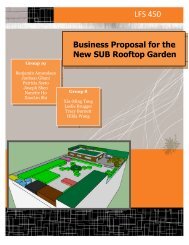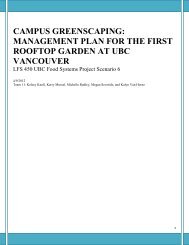APSC 261 Sustainability Project An Investigation into ... - My New Sub
APSC 261 Sustainability Project An Investigation into ... - My New Sub
APSC 261 Sustainability Project An Investigation into ... - My New Sub
You also want an ePaper? Increase the reach of your titles
YUMPU automatically turns print PDFs into web optimized ePapers that Google loves.
<strong>APSC</strong> <strong>261</strong> <strong>Sustainability</strong> <strong>Project</strong><br />
<strong>An</strong> <strong>Investigation</strong> <strong>into</strong> Energy Generating Tiles Pavegen<br />
<strong>Sub</strong>mitted to Dr. Steve Oldrige and the AMS Stakeholders<br />
By: Zhen Liang Seow (28045094)<br />
Song Tao Chen (29172095)<br />
Nor Bainin Khairudin (29657095)<br />
Source: <br />
University Of British Columbia<br />
Applied Science <strong>261</strong><br />
November 24, 2011<br />
1
Abstract<br />
Clean, renewable and environmentally friendly energy generation has always been an issue that<br />
needs to be solved. Technologists have created various methods such as solar panels, wind<br />
turbine, hydro electricity and so forth. However, Pavegen has come up with another innovative<br />
idea, which is to generate electricity from kinetic energy. Since there are a large number of<br />
students patronizing the Student Union Building, the AMS is considering installing Pavegen tiles<br />
<strong>into</strong> the new SUB building in an effort to promote sustainability. This paper will investigate the<br />
advantages and disadvantages of the installation of Pavegen using triple bottom line assessment.<br />
From the economical aspect, the tiles payback period is much longer than the lifetime of the tiles<br />
which means that the cost of this project exceeds its economical benefit. Meanwhile, from the<br />
social aspect, there is a possibility that Pavegen can help raise the awareness of sustainability<br />
amongst the students patronizing the SUB and strengthen the image of UBC as global leader of<br />
sustainability. However, Pavegen may bring up some ethical issues such as harvesting human<br />
energy without their consent. Lastly, from the environmental aspect, based on an observation and<br />
a few assumptions, the total evergy Pavegen will produce in its lifetime is found not able to<br />
cover the carbon footprint resulted from the manufacturing and shipping of the product.<br />
In conclusion, triple bottom line assessment shows that the implementation of Pavegen in the<br />
new SUB will be beneficial to the society but will negatively impact the economy and<br />
environment. Unless another company that manufactures a similar product is chosen from the<br />
United States or Canada, it is recommended that UBC should not install the tiles.
Contents<br />
List of illustrations .......................................................................................................................... 1<br />
List of abbreviations ....................................................................................................................... 2<br />
Introduction ..................................................................................................................................... 3<br />
1 Applications and Calculations ................................................................................................. 4<br />
1.1 Application of Pavegen .................................................................................................... 4<br />
1.2 Amount of Power Generated ............................................................................................ 5<br />
2 Economic analysis ................................................................................................................... 7<br />
3 Social Assessment ................................................................................................................... 8<br />
3.1 Change in Knowledge and Ways of Living ..................................................................... 8<br />
3.2 Change in Employment Rate............................................................................................ 9<br />
3.3 Ethical Issues .................................................................................................................... 9<br />
3.4 Safety .............................................................................................................................. 10<br />
4 Environment assessment........................................................................................................ 11<br />
4.1 Shipping ......................................................................................................................... 11<br />
4.2 Manufacturing ................................................................................................................ 11<br />
4.3 Disposal .......................................................................................................................... 12<br />
4.4 Energy ............................................................................................................................ 12<br />
4.5 Result of environmental assessment .............................................................................. 12<br />
4.6 Alternative products ....................................................................................................... 12<br />
Conclusion and Recommendation ................................................................................................ 14<br />
Reference ...................................................................................................................................... 15
List of illustrations<br />
Figure 1: Normal distributed graph of people passing through SUB daily<br />
Figure 2: The deflection of Pavegen on stairs.<br />
Table 1: One month bill for various provinces<br />
1
List of abbreviations<br />
AMS Alma Master Society<br />
CDN Canadian Dollar<br />
CH4 Methane<br />
CO2 Carbon Dioxide<br />
GHG Green House Gas<br />
H Height<br />
kWh kilo Watt hour<br />
L Length<br />
LCA Life Cycle Assessment<br />
LED Light Emitting Diode<br />
SUB Student Union Building<br />
UBC University of British Columbia<br />
W- Width<br />
2
Introduction<br />
Pavegen tiles is a device that generates electricity by converting kinetic energy that is obtained<br />
when mechanical stress is applied on the device. When someone steps on the tile, a certain<br />
amount of energy will be generated and stored in the built-in battery, which will power low<br />
energy consumption appliances such as street light, alarms and battery charger. In the new SUB,<br />
this energy can be used to power up the LED display that highlights the sustainable features of<br />
the building.<br />
Pavegen Company claims that the durability of its product is 20 million steps (Gizmag, 2011).<br />
Each footstep on a tile can generate about 0.29 watts per hour on average (based on our<br />
calculation in the following section). Meanwhile, the battery can be customized depending on the<br />
requirements. The cost of each tile is $4,052CDN, taxes not included. The product is made of<br />
recycled rubber and aluminum (WorldArchitecture<strong>New</strong>s, 2011). The AMS is considering on<br />
introducing this device <strong>into</strong> the new SUB by placing eight tiles of this device on the main<br />
stairway. In this paper, an assessment on the product is done using triple bottom line assessment<br />
that investigates the product<br />
For the economic assessment, we calculated the breakeven point to find out what the lifetime of<br />
the Pavegen tiles ought to be to cover the costs. We also compare with other alternativeenergy<br />
source that can be purchased using the same amount of money used to cover the costs of the<br />
Pavegen tiles. For social assessment, sustainability awareness raised by implementing this<br />
product is used as an indicator. Futhermore, the safety and ethical issue are taken <strong>into</strong><br />
consideration. Finally, for the environmental assessment , carbon footprint of shipping,<br />
manufacturing and diaposal is calculated and compared to the carbon footprint Pavegen will save<br />
over its lifetime.<br />
3
1 Applications and Calculations<br />
1.1 Application of Pavegen<br />
In the past, being sustainable was never an important issue to technologist. Their main goal is to<br />
<br />
environment in return. However, currently in many universities, engineering and science students<br />
are being educated on the importance of being sustainable and designing products that are pro<br />
environmental. In order to spread this idea to the public and society, Pavegen has introduced tiles<br />
that generate electricity with every step on it. This energy in return can be used to power street<br />
lights, displays, speakers, alarms, signs or advertising (Gizmag, 2011).<br />
Now, the tiles are being used in many places that have a high concentration of people passing<br />
through and many more are planning to do so as well. For example, Westfield Stratford City<br />
Shopping Centre is planning on installing the tiles and uses the generated power to power up the<br />
<br />
ween the<br />
<br />
<br />
Pavegen<br />
<br />
addresses so many of the issues that are important to young people today -<br />
<br />
(Frontier, 2011). The tiles are able to create and raise<br />
awareness of the students about the topic of being sustainable and the usage of renewable energy.<br />
Installing Pavegen tiles in the SUB corresponds to the objective of the company and may help<br />
spread the idea about sustainability. However, there are other points to be considered other than<br />
just raising awareness and they will be discussed further in this paper.<br />
4
1.2 Amount of Power Generated<br />
To make an analysis about the tiles, we first must calculate the amount of power they are<br />
able to generate in their lifetime. In a newspaper article on Washington State University,<br />
Kemball-<br />
<br />
Peters, 2011).<br />
According to Lawrence Berkeley National Laboratory (Standby Power, 2011), 1 cellphone<br />
needs about 3.68W per hour for 2 hours to be fully charged. Based on these data and the<br />
information given by Kemball-Cook, the energy generated by each footstep is calculated as<br />
follows:<br />
10000*2*3.68Wh = 73.6kWh<br />
Energy per footstep = 73.6kWh / 250000 footsteps<br />
= 0.294Wh per footstep on average<br />
On Thursday October 20 th , we observed the number of people walking through the stairs in<br />
front of a sushi place in SUB and recorded the data as seen below.<br />
Using data from our four 1-hour time slots, we plotted a normal distributed graph to<br />
estimate the amount of people that walks through the SUB every day. Figure 1 shows the bell<br />
curve plotted using computer software. By summing up the amount of people over the 10 hours<br />
in a day, we estimated about 6200 people walk through that stair every single day.<br />
5
Figure 1: Normal distributed graph of people passing through SUB daily<br />
With the information above, we calculate the energy that the product is able to generate<br />
over its lifetime. We made an assumption that the 6200 people will pass by everyday for 5 days a<br />
week and 4 weeks a month. Realistically, the above assumptions do not hold all the time,<br />
especially in summer. However, we used these assumptions to simplify the calculation. Based on<br />
the assumption above, the amount of passerby in the SUB for a year will be:<br />
5days a week * 4weeks a month * 12 months a year * 6200 steps a day = 1488000 steps<br />
With another assumption that each passerby will step on at least two tiles, the energy<br />
generated every year will be:<br />
1488000 steps * 2 tiles * 0.293Wh per step = 863kWh per year<br />
Since the lifetime of the product is 20 million steps (Gizmag, 2011), the lifetime in years is<br />
estimated to be:<br />
20000000 / 1488000 = 13.4 years.<br />
Energy generated over Pavegen lifetime will then be:<br />
863kWh per year * 13.4 years = 11.6MWh.<br />
6
2 Economic analysis<br />
Our team researched on the Pavegen tiles and analysed it by computing its breakeven point<br />
and comparing it with other energy that has equal cost and output. These will be the indicators<br />
for the economic assessment.<br />
With the result of the calculation for the energy generated above, we know that 863kWh is<br />
generated every year. This means every month, we generate an average of 71.9 kWh. From the<br />
table 1, we will compare the energy generated with energy that can be purchased from BC Hydro.<br />
Using the generated energy, every month we will save approximately 71.9 / 375 * 30.15 = $5.78.<br />
The lifetime of the tiles is approximately 13.4 years. Therefore, in its lifetime, we can save $5.78<br />
* 12 months * 13.4 years = $929.40 on our energy bill.<br />
Table 1: One month bill for various provinces<br />
< Source: http://www.hydro.mb.ca/regulatory_affairs/energy_rates/electricity/utility_rate_comp.shtml><br />
However, the cost for all eight tiles are approximately $30800 and we are only saving $ 929.40<br />
throughout its lifetime. This means, we are losing $30800 - $929.4 = $29870.60. Ignoring the<br />
expected lifetime of the tiles, the breakeven point can only be achieved after 30800 / (5.78 * 12)<br />
444 years. This means that the payback period is approximately 444 years and this is obviously<br />
unachievable. Thus, based on the above, we came to the conclusion that the Pavegen tiles are not<br />
beneficial to UBC based on the economic point of view alone.<br />
7
3 Social Assessment<br />
Social assessment is defined as the estimation, in advance, of the social consequences from a<br />
project development (Becker et.al. 2003). Social assessment has its own measurable units which<br />
are different from economy and environmental assessments. In Becker<br />
several indicators for social assessment. The most relevant indicators chosen to measure the<br />
social impact by Pavegen are:<br />
i: change in knowledge and ways of living<br />
ii: change in employment rate<br />
iii: ethic issues<br />
iv: safety<br />
3.1 Change in Knowledge and Ways of Living<br />
The purpose of installing Pavegen tiles in the new SUB is to provide an alternative way to<br />
generate electricity and to promote sustainability. Although there are other cheaper renewable<br />
energy sources like solar panels and wind energy harvesting, they do not engage people in the<br />
process. According to the website of North Tipperary County Council, the best way to promote<br />
sustainability is by involving the local community in the sustainability effort (North Tipperary,<br />
2011). Pavegen tiles need students to step on it in order to generate electricity, which is a direct<br />
involvement of the society in the process of achieving sustainability and this will raise their<br />
awareness of sustainability.<br />
Pavegen <br />
living too. A research was done by Volkswagen<br />
<br />
lazy behaviour can be changed. The results show that there is 66% more people<br />
using the stairs than the elevator because it is interesting (Dugdale, 2011). Similar achievement<br />
can be done by Pavegen as an LED will light up when people step on the tile. Installing Pavegen<br />
tiles <br />
Although there is a 5% consumption of the energy generate to light up the LED, it is worthy<br />
because the LED will attract more people to use the stairs and indirectly make them more aware<br />
that what they are doing is sustainable.<br />
8
Pavegen founder, Laurence Kemball-<br />
Schools are a great way for people to<br />
learn about energy efficiency<br />
Harris, 2011). By installing Pavegen tiles in the<br />
SUB, the knowledge about sustainability among the students can be increased too. Soon,<br />
students will also realise that, every little thing they do in their life can impact in the achievement<br />
of sustainability, which will also inspire them to create a product that has similar concept with<br />
Pavegen or even find out other innovative ways to generate energy.<br />
3.2 Change in Employment Rate<br />
Installing Pavegen tiles in SUB will not increase the job opportunity in Canada in a short<br />
period of time. In the interview with Kemball-Cook, he mentions that Pavegen does not show<br />
any interest of starting company overseas (Harris, 2011). However, Pavegen tiles will need<br />
maintenance, so engineers in Canada can be trained in Pavegen company in UK to help<br />
maintaining Pavegen tiles<br />
With the established reputation of UBC as a global sustainability leader, the use of Pavegen<br />
tiles will be known by the rest of Canada. When Pavegen gets popular enough, Pavegen might<br />
consider starting a company in Canada which will increase more job opportunities. However,<br />
that is a long term process which will not happen anytime soon.<br />
3.3 Ethical Issues<br />
One of the concerns associated with the installation of Pavegen is that Pavegen works by<br />
harvesting human energy without their consent. Hilario, in his thesis of energy harvesting<br />
<br />
<br />
(Hilario, 2011). By right, UBC owns the Pavegen tiles so, UBC claims the energy generated and<br />
use the energy to power the light and LED TV in the SUB without paying the students anything.<br />
This could possibly be an infringement of human rights. However, if the tiles are installed in<br />
such a way that students are able to choose whether they want to step on tiles or not, this issue<br />
will not be a problem as UBC does not force them to generate electricity.<br />
<br />
people will have to eat more (Glaskowsky, 2007). However, Chapple argues that, some<br />
scarification must be made in order to achieve sustainability (Chapple, 2008). In this case, the<br />
9
sacrifice the students have to make is just to use a little of their energy to power the lights in the<br />
SUB and this is small in comparison to their contribution in making the world a better place to<br />
live in.<br />
3.4 Safety<br />
When people step on the surface of Pavegen tile, it deflects by 5mm as shown in figure 2 to<br />
generate electricity (Harris, 2011). Since UBC is planning to install Pavegen tiles on the stairs in<br />
new SUB, our team did some research to see if this will be a tripping hazard. Inspectapedia.com<br />
<br />
more than 3/8 of an inch (9.525mm) in variation of the height of steps<br />
<br />
Inspectapedia, 2011). Since Pavegen only deflects<br />
by 5mm, it is safe to be installed on the stairs.<br />
5mm<br />
Figure 2: The deflection of Pavegen on stairs.<br />
10
4 Environment assessment<br />
The environmental analysis of Pavegen is the assessment of its total carbon footprint.<br />
Carbon footprint is a measure of total amount of carbon dioxide (CO2) and methane (CH4)<br />
emission of a defined population, system or activity (Wikipedia, 2011). It is an important method<br />
for the measurement of the impact of an object or a product on the environment. The carbon<br />
footprint of a product refers to the GHG emissions of the assessed product across its life cycle,<br />
the formation of raw materials through production, distribution, consumer use and disposal<br />
(Iribarren et. al. , 2010). In this project, the carbon footprint of Pavegen system is measured and<br />
will be used as the indicator for the environmental impact of Pavegen tiles. The main factors of<br />
the Pavegen system that contribute to the carbon footprint are the shipping, the manufacturing,<br />
the disposal and the amount of renewable energy it is able to produce.<br />
4.1 Shipping<br />
Pavegen Company is located in London and its product is manufactured locally. However,<br />
since UBC is located in Vancouver, thus the product will be used in Vancouver and this will<br />
cause shipment to be a major factor that may cause a large carbon footprint. The estimated<br />
emission of CO2 from London to Vancouver is about 0.67 ton (Carbon Footprint, 2011).<br />
4.2 Manufacturing<br />
The size of the product is 600*450*87 (L*W*H) mm and it is made of stainless steel as the<br />
base and covered by 95% recycled rubber on the top (WorldArchitecture<strong>New</strong>s, 2011). <strong>An</strong>alysis<br />
shows that the mean carbon footprint of the average rubber is 0.153 ton of CO2 per metric ton. In<br />
comparison, the use of recycled rubber in moulded products provides a substantial carbon foot<br />
advantage over the use of virgin plastic resins, having between 4 and 20 times lower carbon<br />
footprint (Tire Recycling, 2011). In this case, the total estimated carbon footprint of rubber to be<br />
used in the Pavegen system is about 0.0857 kg of CO2. Moreover, the carbon impact of steel<br />
products in the UK is 0.919 ton per ton (TATA Steel,2011). This implicates that the estimated<br />
carbon footprint of steel to be used in Pavegen system is 1.5kg of CO2. The total CO2 emission<br />
in this project is estimated to be 1.5857 kg of CO2.<br />
11
4.3 Disposal<br />
Since Pavegen Company is located in London, they cannot offer recycling products in<br />
Vancouver. The product is mostly made of steel and recycled rubber, hence it can be recycled.<br />
Recycling products is a good way to reduce carbon footprint. The product stores energy using<br />
lead acid and lithium battery and the toxic chemical and heavy metal can be a potential hazard to<br />
the environment. Hence, the disposal method of the product is an important issue. The carbon<br />
footprint of recycling battery is uncertain. However, it can be estimated to be very small since<br />
Pavegen Company uses the technology that can not harm the battery. Unlike other kinetic<br />
energy-harvesting systems based solely on piezoelectricity, the technology Pavegen uses gives<br />
constant flow of energy which, on large scale, extends the lifetime of the battery (Harris, 2011).<br />
4.4 Energy<br />
Based on the calculations made in the economical analysis of Pavegen provided above, the<br />
total energy Pavegen produces in its life time is computed to be 11.65MWh. In Canada, the LCA<br />
emission factor for hydropower is 0.024 ton CO2/MWh (Covenarnt of Mayors, 2011). Therefore,<br />
the energy that Pavegen produces in its lifetime can save approximately 0.28 ton of CO2.<br />
4.5 Result of environmental assessment<br />
Based on the analysis above, the total carbon footprint of Pavegen will save in its lifetime<br />
is calculated to be 0.67 + 0.002 - 0.28 = 0.39 ton, which means that Pavegen project will release<br />
0.39 ton CO2 to the environment in its lifetime. Since the result of the assessment is opposite to<br />
<br />
effect, and it is not wise to introduce this device to the new SUB. However, the major cause of<br />
the carbon footprint is its shipping. If the shipping distance can be largely reduced, then the<br />
device will be recommended.<br />
4.6 Alternative products<br />
There are a few companies starting to make equivalent products. For example,<br />
POWERleap is a company that located in Michigan USA. However, since POWERleap is only<br />
on the prototype stage, there is not much information found. On the other hand, the location of<br />
the company is a good advantage since it is located nearer to Vancouver compared to the<br />
Pavegen and this can reduce the shipping carbon footprint. Considering that the new SUB<br />
12
project will only start in one year, during this time, if POWERleap or any other similar<br />
companies in Canada or the United States is able to start manufacturing, they should be taken<br />
<strong>into</strong> consideration.<br />
13
Conclusion and Recommendation<br />
In conclusion, in terms of economy, Pavegen tiles are not feasible as its payback period is<br />
much longer than its lifetime. In terms of environmental, it produces more carbon footprint than<br />
the generated energy can save. However, it has some social advantage in which it can help raise<br />
the awareness of the society in UBC about the importance of sustainability.<br />
Based on the result of the analysis done as seen above, we recommend that AMS do not<br />
install the Pavegen in the SUB unless Pavegen opens a manufacturing branch in north America.<br />
We also recommend that AMS to consider purchasing from another company that can<br />
manufacture a similar product such as POWERLeap that is based in north America since this can<br />
help reduce both the price and the carbon footprint produced by shipment.<br />
<strong>An</strong>other option is to e<br />
promote our sponsors and at the same time reduce the cost that we have to spend on the tiles<br />
through sponsorship.<br />
14
Reference<br />
Becker, H. A., & Vanclay, F. (2003). The international handbook of social impact assessment:<br />
Conceptual and methodological advances. Northampton, MA, USA: Edward Elgar.<br />
Carbon Footprint - Carbon Footprint Calculator. (n.d.). Carbon Footprint - Home of Carbon<br />
Management. Retrieved November 23, 2011, from<br />
http://www.carbonfootprint.com/calculator.aspx<br />
Carbon footprint - Wikipedia, the free encyclopedia. Wikipedia, the free encyclopedia. Retrieved<br />
November 23, 2011, from http://en.wikipedia.org/wiki/Carbon_footprint<br />
Chapple, C. K. (2008). Sacrifice and sustainability. World Views: Global Religions, Culture, and<br />
Ecology, 12(2-3), 221-221.<br />
Clark, B. (n.d.). Pavegen tiles harvest energy from footsteps. Gizmag | <strong>New</strong> and Emerging<br />
Technology <strong>New</strong>s. Retrieved November 23, 2011, from http://www.gizmag.com/pavegen-tileskinetic-energy-harvesting/20235/<br />
Cotter, M. (2011, September 28). In inhabitat. Retrieved October 20, 2011, from<br />
http://inhabitat.com/award-winning-pavegen-floor-tiles-will-use-energy-from-footsteps-to-lightup-uk-shopping-center/<br />
Covenant of Mayors. (n.d.). Covenant of Mayors. Retrieved November 23, 2011, from<br />
http://www.eumayors.eu/IMG/pdf/technical_annex_en.pdf<br />
Diego Iribarren, Ian Vázquez-Rowe, Almudena Hospido, María Teresa Moreira, Gumersindo<br />
Feijoo, Estimation of the carbon footprint of the Galician fishing activity (NW Spain), Science of<br />
The Total Environment, Volume 408, Issue 22, 15 October 2010, Pages 5284-5294, ISSN 0048-<br />
9697, 10.1016/j.scitotenv.2010.07.082.<br />
Dugdale, A. (n.d.). Piano Stairs aim to get Stockholm butts moving | DVICE. DVICE. Retrieved<br />
November 23, 2011, from http://dvice.com/archives/2009/10/piano-stairs-ai.php<br />
Electricity - Utility Rate Comparisons. (n.d.). Manitoba Hydro Electric Energy and Natural Gas.<br />
Retrieved November 23, 2011, from<br />
http://www.hydro.mb.ca/regulatory_affairs/energy_rates/electricity/utility_rate_comp.shtml<br />
Frontier PR | One step beyond for Kent Grammar School | . (n.d.). Frontier PR | Home | .<br />
Retrieved November 23, 2011, from<br />
http://www.frontierpr.co.uk/news/press_releases/onestep_beyond_for_kent_grammar_school/<br />
Glaskowsky, P. (2007, September 17). Human energy harvesting -- a very silly idea. CNET<br />
<strong>New</strong>s. Retrieved October 19, 2011 from http://news.cnet.com/8301-13512_3-9779334-23.html<br />
15
Harris, S. (n.d.). Pavegen founder Laurence Kemball-Cook | In-depth | The Engineer.<br />
Engineering <strong>New</strong>s & Engineering Jobs | The Engineer. Retrieved November 23, 2011, from<br />
http://www.theengineer.co.uk/in-depth/interviews/pavegen-founder-laurence-kemballcook/1010877.article<br />
Hilario. A.J. (2011, May). Energy Harvesting From Elliptical Machines Using Four-Switch<br />
Buck-Boost Topology. Retrieved October 19, 2011 from<br />
http://digitalcommons.calpoly.edu/cgi/viewcontent.cgi?article=1541&...<br />
North Tipperary County Council. (2011). Vision for North Tipperary - Achieving <strong>Sustainability</strong>.<br />
Retrieved October 19, 2011 from<br />
http://www.tipperarynorth.ie/countydevelopmentplan/vis_achs.html<br />
Peters, D. E. (n.d.). Stepping Up to a Bright Idea - Marketing, <strong>New</strong>s, and Educational<br />
Communications. Marketing, <strong>New</strong>s, and Educational Communications. Retrieved November 24,<br />
2011, from http://cahnrsnews.wsu.edu/2011/11/01/stepping-up-to-a-bright-idea/<br />
Stair step height: Guide to Stair Riser Dimensions in Stair Codes, Construction & Stair<br />
Inspections. (n.d.). In InspectAPedia online. Retrieved from<br />
http://www.inspectapedia.com/interiors/Stair_Risers.htm<br />
Standby Power : Data. (n.d.). Standby Power. Retrieved November 24, 2011, from<br />
http://standby.lbl.gov/summary-table.html<br />
The carbon footprint of steel. (n.d.). beams | columns | composite flooring | sustainability.<br />
Retrieved November 23, 2011, from<br />
http://www.tatasteelconstruction.com/en/sustainability/carbon_and_steel/<br />
Tire Recycling Equipment Manufacturer Shredders . (n.d.). Tire Recycling Equipment<br />
Manufacturer Shredders . Retrieved November 23, 2011, from<br />
http://www.cmshredders.com/Public/14864/FinalRubberTireRecyclingCarbonFootprint.pdf<br />
WorldArchitecture<strong>New</strong>s, Pavegen Systems, Product. (n.d.). World Architecture <strong>New</strong>s, Official<br />
Home Page, architecture news, architecture jobs. Retrieved November 23, 2011, from<br />
http://www.worldarchitecturenews.com/index.php?fuseaction=wanappln.projectview&upload_id<br />
=12560<br />
Webster, G. (2011, October 13). Green sidewalk makes electricity -- one footstep at a time. CNN<br />
Tech. Retrieved October 20, 2011, from<br />
http://www.cnn.com/2011/10/13/tech/innovation/pavegen-kinetic-pavements/<br />
16


